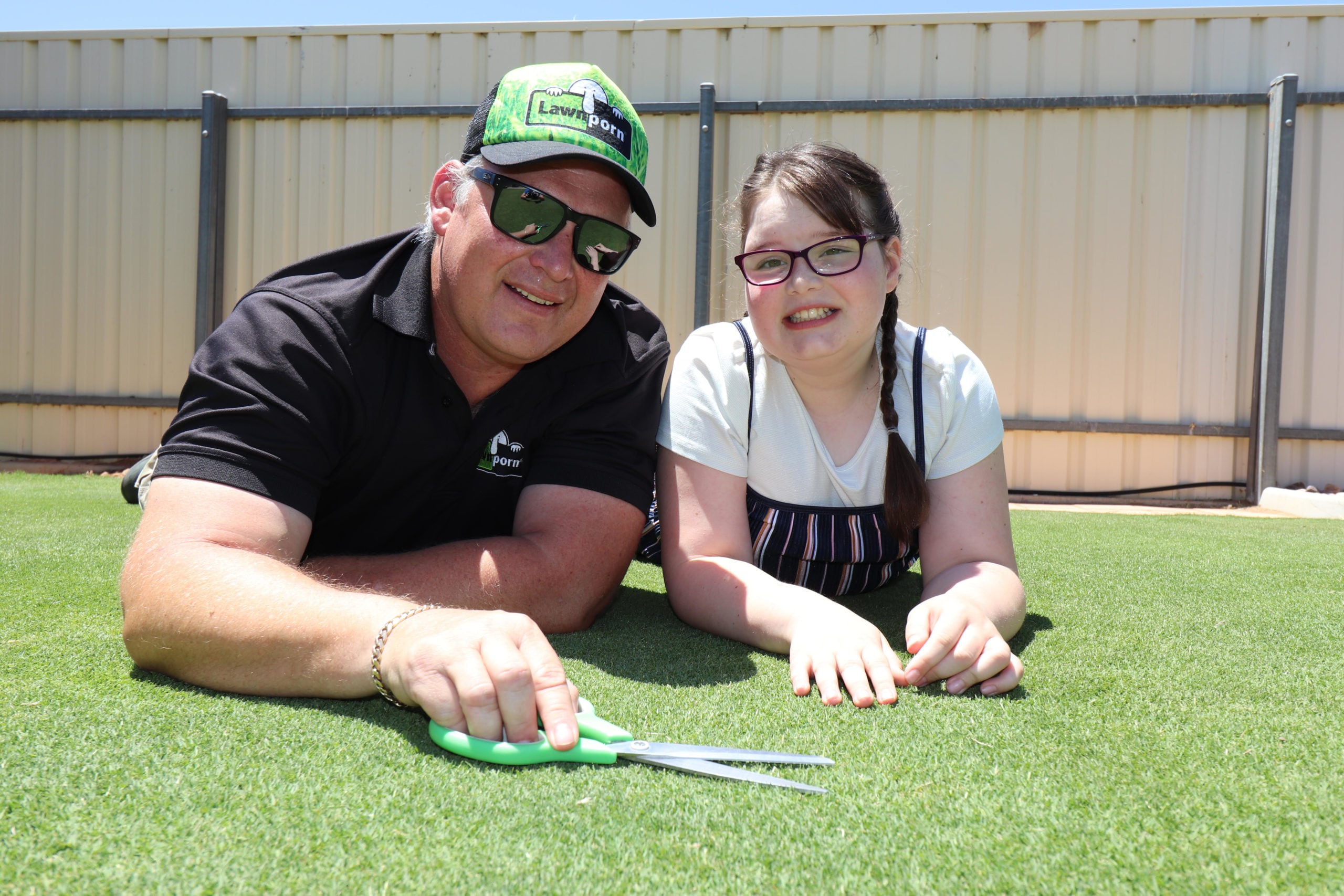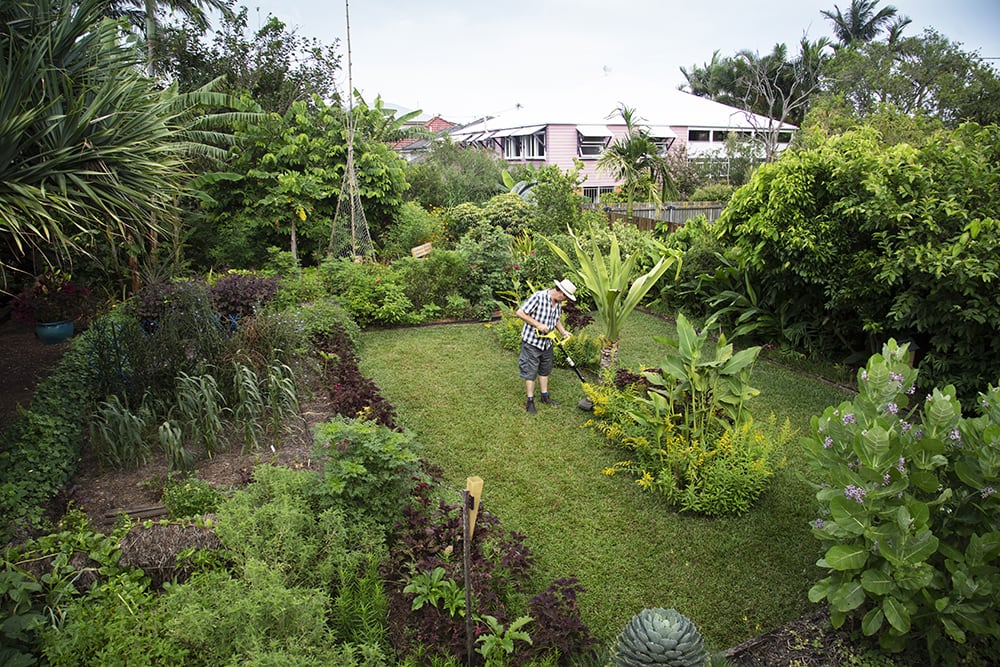AT THE AGE OF 13, Matt Daum became “the man of the house” when his father passed away. He began maintaining his family’s lawn and, over the years, discovered he had a knack for keeping it healthy.
Now in his 40s, Matt spends about three hours every weekend lovingly tending his lawn in Whyalla, South Australia, using an old-fashioned cylinder mower that “cuts like a pair of scissors”. He also runs a lawn appreciation page on Facebook.
Matt started the page three years ago when he was forced to take time off from his job as a police officer following an injury.
The page, named Lawnporn after a moniker Matt’s friends had given his lawn, very quickly gained traction. Matt posted lawn care tutorials and launched a lawn photo competition that attracted entrants from right across Australia. “I got some prizes from local businesses and hoped to get about 50 entries,” Matt says. “But I got 22,000 – it was crazy.”
These days, Matt receives about 100 queries a day about lawn care. He has also released a range of fertilisers and there is even talk of a TV show. “Some people follow me quite obsessively,” he says. “They want to know everything that I’ve used and do everything that I do.”

Negatives outweigh the positives
Australia has no shortage of lawn enthusiasts, but recent studies from the USA and Sweden throw shade on the traditional grass lawn.
Researchers have found that positive environmental impacts of lawns – such as oxygen production, carbon sequestration, water run-off reduction and soil erosion mitigation – are outweighed by a series of negative ones. These include the large volumes of water needed to maintain lawns, pesticide use and pollution from fume-emitting mowers.
Lawns also take up space, which could otherwise be used for vegetation that provides different types of habitat for native wildlife.
Good alternatives to lawns include drought-resistant native plants, strategically placed shrubs and low-growing species, and materials such as mulch and stones.
Critics of traditional lawns say that more variety would also be an aesthetic plus. Lawns make up almost half of the urban green areas globally, and this creates a homogenised look. However, common alternatives such as chamomile, thyme and wild strawberries are unsuitable for Australia’s climate.
They’re also not natives. Finding substitutes in Australia is considered more complicated than in the Northern Hemisphere because of our unique climate and vegetation.
The Melbourne-based Woody Meadow Project is regarded as a successful case study for finding alternatives. The project, which is a collaboration between the City of Melbourne, the University of Melbourne, and the University of Sheffield, in the UK, began in 2015 and has seen a series of native shrub gardens – woody meadows – planted across the city. The idea is to create urban gardens that are “diverse and attractive yet require minimal maintenance”.
The researchers involved have filled the plots, which include a 200sq.m garden in Birrarung Marr, near Federation Square, with flowering native plants that provide good ground cover and attract birds and insects.
While not all 21 species planted have performed as well as expected, the project has been successful and is likely to be expanded to different climates and ecosystems in Australia and overseas.
But could anything ever be as popular as lawn, which dates back to medieval times? “I think humanity has a very intimate, long-term association with grasses, and the landscapes they form,” says Jerry Coleby-Williams, a conservationist, horticulturalist and presenter on ABC TV’s Gardening Australia. “It’s part of our psyche as a species.”
A somewhat radical alternative is xeriscaping, a style of landscaping that promotes water efficiency. The term was coined by staff at the Denver Water department, in the USA, in 1981. The prefix ‘xero’ means dry in Greek, indicating the idea that it’s designed to reduce or eliminate the need for watering.
To become popular, however, xeriscaping needs to overcome a perception that it represents little more than unappealing collections of cactuses and stones.
Moreover, lawn connoisseurs, including Matt and Jerry, contend that well-maintained lawns use little water. Both men invest a great deal of effort in educating the public on water-use efficiency.
Other experts say that expecting a lawn to be green year-round in a dry climate is misguided. Shane Holborn, who is currently a research facility manager with the Queensland Department of Agriculture and Fisheries, is among them. In 2013 he wrote a report, as an independent researcher funded by Horticulture Innovation Australia, on the environmental benefits of turf.
“Many people don’t realise that a brown-looking lawn will come back to life,” he says.

The environmental impact of lawns
Shane argues there is no easy way to answer questions about the ecological footprints of lawns.
“There are so many variables in determining the environmental impact of lawns – whether it’s cool season or warm season grass, a broad leaf or a narrow blade, and what’s in the soil,” he says. “It’s too complicated for anyone to really have a firm answer, without undertaking a lot of research.”
Furthermore, Jerry says, there are good and bad ways of caring for lawns that have different environmental impacts.
“I think the studies are misplaced,” he explains. “They tend to study things that confirm a perspective. If you want to study bad practice, that’s fine. But you can’t just say that, for example, because an SUV consumes a whole lot of fossil fuels, that every form of vehicle transport is equally bad.”
At Bellis, his award-winning sustainable house and garden in Brisbane, Jerry uses a solar-powered lawnmower and recycled rainwater. “What I’ve got here [in my garden] is the equivalent of cutting-edge transport,” he says. “I have highly productive organic inputs to produce brilliant, worm-filled soil. I also incorporate native biocontrols to eliminate the use of pesticides.”
Another major criticism of traditional lawns is that they do not provide habitat for wildlife. But Shane says this is not entirely true.
“Lawns do provide a habitat and feeding area to some degree, because the birds pick the insects out,” he says. “You might not find a koala there, but you will find wallabies and kangaroos.” Shane also believes recreational and residential lawns have little in common with elite sporting turfs, which are highly resource intensive.
And Jerry agrees: “It’s a bit unfair to say that ornamental turf for parks and gardens is necessarily anything like a sporting surface, which requires precision in its maintenance. And because they [sporting surfaces] are what they are, they generate huge amounts of income. Imagine the economic costs if the Melbourne Cricket Ground were to be ploughed over.”
Shane adds that the social benefits of lawns should be considered when weighing up alternatives. “The reason why we’re such a sporting nation is we’ve got these big areas of grass that we can play on,” he says. “There’s that element of health and wellbeing and combating obesity that ties into this whole discussion.”
Synthetic turf
During the millennium drought of the early 2000s, synthetic grass began to gain traction as a water-free and low-maintenance alternative to natural grass, particularly for sportsgrounds. Shane says, however, that the downsides are considerable.
“There’s a whole heap of misery in that product,” he says. “You can end up with carpet burns and infections from sliding on it. It’s unpleasant to think about, but if you get saliva, sweat, blood or dog faeces on it, all that bacteria just stays there if it’s not removed. Natural turf processes those things on its own.”
Injury levels are higher on synthetic turf due to its hard underlay and some sporting teams have boycotted playing matches on it. “I think calling it artificial turf is a misnomer,” Shane says. “It’s not a substitute for lawns. It’s a substitute for concrete.”
One of the most worrying, albeit so far unproven, concerns, is that synthetic turf could cause cancer. This is because the chemicals in car tyres that are turned into crumbs to support the synthetic grass blades are known carcinogens.
Critics of synthetic turf claim that more research is needed. It’s also not suited to children’s play areas because it gets extremely hot. There are case studies of it becoming so hot that it’s melted shoes.
“We’ve put infrared thermometers on synthetic turf and found that it gets 20oC to 30oC hotter than natural grass,” says Jarrod Bird, president of the Sports Turf Association of Queensland and head grounds manager of the Queensland Cricket Association.
Another downside of synthetic turf is that it has a life span of only 10 years, after which time it must be thrown into landfill because it can’t be recycled.
“We can repair damaged patches of natural turf, but, once synthetic turf is damaged, you have to rip it up and start again,” Jarrod says, adding that the perception of synthetic turf requiring little maintenance is inaccurate. “We see a lot of bowling clubs switch to synthetic turf because they think it doesn’t require any maintenance, and then it ends up costing them more down the track because they haven’t looked after it.”
But Gary Green, president of the Mitchelton Football Club in Brisbane, says that since a $1.5 million artificial playing field was laid at his club in August last year, players have had nothing but praise for it.
“We have little kids up to a guy who’s 62 playing on it and everyone, especially the older guys, tell me it’s gentler on the body,” he says. The main reason the club switched to artificial turf was because they were running out of space and the synthetic field can be used more frequently – 75 hours a week compared with 15 for a natural grass surface.
The use of synthetic turf in public areas such as nature strips is dividing communities.
In May last year, the City of Marion council in Adelaide lifted a ban on using artificial turf on council verges, causing a public outcry. A petition against the move cited the heat generated by artificial turf and its negative environmental impacts. Weeks later, the council overturned its decision and reinstated the ban on artificial turf. Similar disagreements are playing out across Australia.
Fortunately, there appears to be a solution on the horizon – a hybrid grass. It combines natural grass with synthetic reinforcing fibres, making it more resistant to damage than natural grass but helping it avoid many of the downsides of synthetic turf.
Europe already has a number of hybrid football pitches and in Australia, the cricket pitch at the Allan Border Field has hybrid grass, as does a section of oval at the University of Sydney.
“It’s expensive,” Jarrod says, “but I think it could be the surface of the future.”
This article was published in Issue 156 of Australian Geographic. You can purchase you copy here.




